
Submarines - Constraints and Opportunities

The announcement of the AUKUS trilateral partnership between Australia, the United States and the United Kingdom is significant for its explicit focus on cooperation in the Indo-Pacific region. Its first initiative, to support Australia to acquire nuclear-powered submarines and infrastructure – while maintaining commitments to the Non-Proliferation Treaty and International Atomic Energy Agency safeguards regimes – challenges Australia’s strategic, socio-political, economic, and legislative environment.
Among this set of challenges, workforce sustainment and supply chains are sources of extant risk to national security outcomes. When the Department of Defence acquires major capital equipment, it faces an array of internal and external forces and influences that create significant difficulties to navigate.
The key to understanding complex capability problems lies in appreciating the interdependencies between the vast chain of inputs that are fundamental to the development, production, and introduction into service of modern advanced platforms. Analysis clarifies constraints and opportunities, allowing long-term strategies to be designed and implemented in the national interest.
Synergy Group’s recent study of the introduction of nuclear power to Australia’s submarine capability draws on large-scale platform design and expertise in nuclear, maritime, and infrastructure, and reveals constraints and opportunities in workforce and infrastructure that demand strategic solutions at the national level.
At the Indo Pacific International Maritime Conference, the Defence Partner at Synergy Group, Michael Mahy, presented some conclusions on what a successful submarine construction and infrastructure strategy will need to address in order to achieve a better outcome for Australia.
Download the full paper below:
